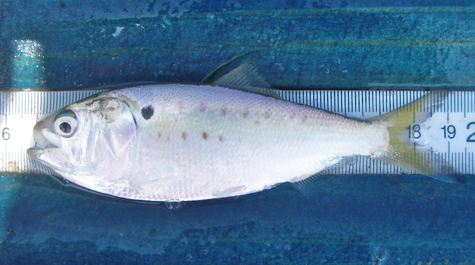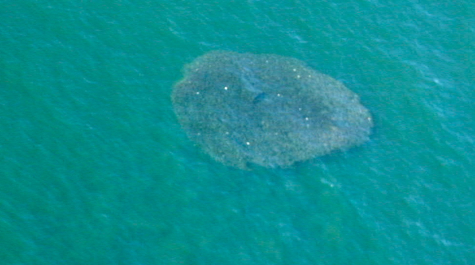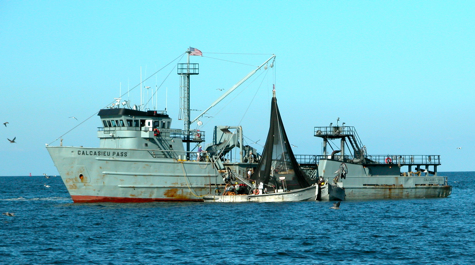Menhaden Background
Ecology & Life History
Atlantic menhaden (Brevoortia tyrannus) are small (maximum length = 15 inches), schooling fish related to herring, shad, and sardines. Menhaden consume large quantities of phytoplankton and zooplankton, and are themselves a favorite food of striped bass, bluefish, sea trout, tunas, sharks, and sea birds. The species inhabits near-shore waters along the Atlantic seaboard from Nova Scotia southward to central Florida.
Menhaden spawn in the ocean, in shelf waters off Chesapeake Bay from March to May, and again in September and October. The young menhaden drift with currents until they reach a coastal inlet, then work upstream to live for the summer. Larvae use brackish and fresh water inlets and estuaries as nursery areas, where they metamorphose into juveniles and grow rapidly. Menhaden are common in all salinities of Chesapeake Bay during the spring, summer, and fall, swimming in large schools near the water's surface.
Young-of-the-year menhaden leave Chesapeake Bay in late fall and join schools in southward migration. During the fall and early winter, most menhaden migrate south to deeper waters off the North Carolina capes, where they remain until March and early April.
Summer die-offs of large numbers of Atlantic menhaden are common in Chesapeake Bay, mostly associated with episodes of low dissolved oxygen (i.e., dead zones) in Bay waters.
Status of the Menhaden Fishery
Menhaden support one of the most commercially important fisheries along the Atlantic Coast, providing fish meal, fish oil, and bait for other fisheries. More pounds of menhaden are landed each year than any other fish in the United States, with coast-wide landings ranging from 300,000 to 400,000 metric tons since the mid-1970s. Since 1980, this fishery has accounted for almost 40% of total annual Atlantic Coast landings by weight. Most of the catch is made by purse seine for the reduction fishery (in which menhaden are "reduced" to fish meal and oil).
Following industry consolidation and closure of most state waters to the reduction fishery in the 1980s and early 1990s, more than half of the total menhaden harvest has shifted to Chesapeake Bay. Although the most recent coast-wide stock assessment by the Atlantic States Marine Fisheries Commission (ASMFC) indicates that the coast-wide menhaden stock is not over-fished, recreational fishing interests and some conservation groups have expressed concern that there could be negative effects of concentrated harvest in Chesapeake Bay.
One concern is that current levels of menhaden removals may lead to "localized depletion" of the stock within Chesapeake Bay, which could undermine menhaden's important ecological role as a principal prey species and filter feeder in Bay waters.
A related concern is that low recruitment of menhaden may be affecting the species' ability to serve as a major food source for other fish. Many recreational anglers contend that the poor nutritional condition of striped bass in Chesapeake Bay in recent years is linked to insufficient forage (menhaden) supply. Although menhaden stock biomass is currently high, it is likely to decline in the next few years due to low recruitment. Studies indicate that environmental conditions are likely more important than the size of spawning stock in determining reproductive success, although there is a weak spawner-recruit relationship.
In 2004, the ASMFC's Atlantic Menhaden Technical Committee discussed the possibility of localized depletion and determined that it was impossible to make a definite conclusion in the absence of data on menhaden abundance and biomass in Chesapeake Bay.
Research Priorities
The paucity of reliable data to evaluate localized depletion of Atlantic menhaden from Chesapeake Bay prompted the ASMFC's Atlantic Menhaden Technical Committee to develop the following list of research priorities (some of which are currently ongoing):
- Determine menhaden abundance in Chesapeake Bay: ASMFC recently funded a pilot study to determine the feasibility of using LIDAR (Light Detection and Ranging) to monitor menhaden abundance. The U.S Environmental Protection Agency (Chesapeake Bay Office) and the NOAA Chesapeake Bay Office have recently funded projects designed to analytically derive estimates of menhaden abundance in Chesapeake Bay.
- Determine estimates of removal of menhaden by predators. Since 2002, the NOAA Chesapeake Bay Office has funded fishery-independent survey work to evaluate predator-prey interactions among commercially, recreationally, and ecologically important living resources in Chesapeake Bay. Estimates of predatory removals of menhaden are currently being developed.
- Quantify the exchange of menhaden between bay and coastal systems. The development of a variety of tagging studies and otolith microchemistry studies have been postulated as promising approaches that can be used to evaluate exchange rates of menhaden between Chesapeake Bay and coastal ecosystems.
- Better understand recruitment dynamics by determining the adundance of larval and juvenile menhaden. Indices of early stage juvenile abundance have been identified as information necessary to better understand recruitment dynamics.
Menhaden Management
Menhaden stocks are managed on a coastwide basis by the Atlantic States Marine Fisheries Commission (ASMFC), under its Menhaden Fishery Management Plan (pdf file). The ASMFC was formed by the 15 Atlantic coast states in 1942 to coordinate the conservation and management of the states' shared nearshore fishery resources for sustainable use.
The Atlantic Menhaden Management Board approved the original Atlantic Menhaden fishery management plan (FMP) in 1981 (access pdf file here). The plan did not recommend any specific management measures, but provided a discussion of options for future consideration. In 1982, the Board recommended seasonal limits as a means to provide long-term benefits to the fishery. This recommendation was approved by the Commission and referred to the states for implementation, however full implementation was not achieved. The FMP was revised in 1992 (pdf file) to include public education; continue the existing fishery monitoring program; improve collection of data on menhaden taken in directed bait fisheries and as bycatch in other fisheries; improve the Captain's Daily Fishing Report (CDFR) program; promote needed research on biological, economic, sociological, and habitat issues; encourage product research; maintenance, and enhancement; and advance use of the best available scientific data as the basis for coordinated management actions.
The ASMFC amended their menhaden plan in April 2001, based on an external peer review of the existing menhaden stock assessment. The review, which was initiated by concern over a real and/or perceived decline in the Atlantic menhaden population, was completed in 1998. Amendment 1 (pdf file) added a new overfishing definition for the Atlantic stock that uses a fishing target and threshold and a stock-size target and threshold. The amendment also restructured the management board and technical committee to reflect the structure of other species management boards and technical committees, and requires mandatory reporting from all menhaden purse-seine fisheries.
The ASMFC Menhaden Management Board added an addendum to Amendment I in March 2004, and another in October 2005. The 2004 addendum addresses biological reference points for menhaden, addresses the frequency of stock assessments, and updates the habitat section currently in Amendment 1. The 2005 addendum institutes a harvest cap on Atlantic menhaden by the reduction fishery in Chesapeake Bay at the average landings from 1999-2004 and identifies a research program for Atlantic menhaden in Chesapeake Bay. The harvest cap will be in place for the fishing seasons starting in 2006 and going through 2010.
The status of the Addendum II harvest cap is currently unresolved, as Virginia's Attorney General issued a ruling in January 2006 stating that the ASMFC's Menhaden Management Board had exceeded their adaptive management authority when adopting the cap. Subsequently, during the 2006 legislative session, members of the Virginia General Assembly either killed or withdrew four separate bills (HB252, HB749, HB1045, and SB84) seeking to cap the annual menhaden harvest in a manner consistent with the provisions set forth in Addendum II.
If Virginia takes no other action to implement the menhaden harvest cap before the July 1, 2006 implementation deadline set forth in Addendum II, the ASMFC will then rule on Virginia's possible non-compliance with the addendum.




